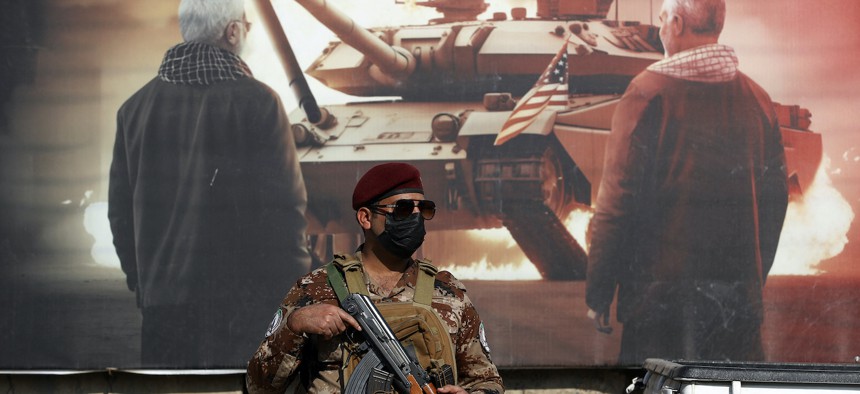
A paramilitary member of the Hashed al-shaabi forces stands guard during the funeral of a comrade who died in an American air strike, at the Hashed al-shaabi forces' headquarters in Baghdad on January 25, 2024. AHMAD AL-RUBAYE / AFP via Getty Images
US launches series of airstrikes in Iraq, Syria
Strikes were a response to deadly drone attack on U.S. troops in Jordan.
This story was updated at 3:20 p.m. Feb. 4.
The U.S. military hit dozens of targets across Iraq and Syria on Friday and dozens more in Yemen on Saturday, targeting Iranian forces and Iran-backed militias.
The strikes in Iraq and Syria were a direct reaction to an explosive drone attack Sunday that killed three American soldiers and wounded more than 40 others at a remote base in Jordan. Those targets included facilities for Iran’s elite Islamic Revolutionary Guards Corps Quds Force, as well as infrastructure for Iran-backed militias that operate collectively as the Islamic Resistance in Iraq.
“Our response began today. It will continue at times and places of our choosing,” President Joe Biden said in a statement Friday afternoon.
The strikes on Saturday targeted locations in "Iranian-backed Houthi terrorist-controlled areas of Yemen," specifically facilities and systems "used to attack international merchant vessels and U.S. Navy ships in the region," U.S. Central Command said in a statement. On Sunday, CENTCOM conducted an additional strike against a Houthi anti-ship cruise missile, which military officials determined was an "imminent threat" to U.S. military and commercial ships in the Red Sea, according to a separate statement.
The strikes followed several days of criticism from Republican lawmakers, many of whom blamed Biden for the attacks on American troops and advocated for airstrikes on targets inside Iran. The White House’s John Kirby on Tuesday told reporters to expect a tiered, likely multi-day U.S. response to the attack in Jordan, but would not say when those attacks would start.
More than 85 targets were struck Friday using multiple aircraft, “to include long-range bombers flown from [the] United States,” military officials at the Tampa-based Central Command said Friday. Those targets, which were hit using at least 125 precision munitions, included “command and control operations, centers, intelligence centers, rockets, and missiles, and unmanned aerial vehicle storages, and logistics and munition supply chain facilities of militia groups and their IRGC sponsors who facilitated attacks against U.S. and Coalition forces,” CENTCOM said.
A military official said poor weather had delayed the strikes. He also said a “number of secondary explosions” resulted at multiple sites, suggesting “we hit exactly what we intended to hit.”
More strikes are expected, Defense Secretary Lloyd Austin said in a separate statement. “The President has directed additional actions to hold the IRGC and affiliated militias accountable for their attacks on U.S. and Coalition Forces,” said Austin. “These will unfold at times and places of our choosing.”
“We believe that the strikes were effective,” the White House’s John Kirby told reporters in a phone call Friday. The U.S. response “began tonight, but it will not end tonight,” he said.
The U.S. strikes in Iraq and Syria “are FAR bigger than any action undertaken before against Iran's proxies,” Charles Lister of the Washington-based Middle East Institute wrote on social media. Witnesses described “huge secondary explosions on both sides of the border suggest big rocket/missile depots have been hit,” he said.
Several strikes landed “outside the Deir Ez Zour Airport, in Jabal Harabesh, in al-Tabani and at the strategically vital Ayyash arms depots,” Lister said of the Syrian side of the border. A militia headquarters was also allegedly hit inside Iraq. “Key here appears to have been degrading command/control & strategic weapons capabilities,” Lister said.
“The United States does not seek conflict in the Middle East or anywhere else in the world,” Biden said. “But let all those who might seek to do us harm know this: If you harm an American, we will respond.”



